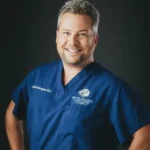More Than Just a Tummy Tuck: Why Massive Weight Loss Requires a Comprehensive Body Transformation
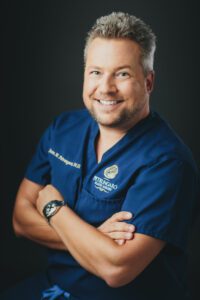
More Than Just a Tummy Tuck: Why Massive Weight Loss Requires a Comprehensive Body Transformation
Have you achieved massive weight loss whether through diet, exercise, or bariatric surgery? Congratulations! You have accomplished a profound, life-altering feat of dedication and resilience. You have literally transformed your health and your future. This is a moment to celebrate your strength.
However, the reality of massive weight loss is that it often leaves behind a significant amount of excess, stretched-out skin. While the medical benefits of your weight loss are clear, this loose skin can cause physical discomfort, hygiene issues, and a persistent emotional disconnect between the person you feel you are now and the body you see in the mirror.
If you are now looking to address this excess skin, you’ve likely researched the tummy tuck (abdominoplasty). But here’s a crucial piece of insight from the world of advanced plastic surgery: for patients with massive weight loss, a standard tummy tuck is often insufficient.
As northwest Indiana’s #1 board-certified Plastic Surgeon, Dr. Jason Petrungaro understands that post-bariatric body contouring requires a specialized, comprehensive approach that goes far beyond a traditional tummy tuck. His commitment is to guide you through this final, transformative stage with honesty, expertise, and a treatment plan tailored to the unique needs of a massive weight loss body.
The Difference: Standard Tummy Tuck vs. Post-Weight Loss Contouring
A standard tummy tuck is designed to tighten the abdominal muscles (diastasis recti) and remove lower abdominal skin laxity from hip to hip in a horizontal direction. This is typically ideal for post-pregnancy patients or those with moderate weight fluctuations.
For those who have lost 70, 80…100 pounds or more, the skin damage is far more extensive. The skin is stretched horizontally, vertically, and circumferentially. The resulting excess skin often wraps around the sides and back, creating a “belt” of tissue that hangs over the waistline. This extensive laxity requires a much more powerful solution.
The Comprehensive Solution: The Body Lift and Circumferential Tummy Tuck
When the skin laxity extends around the entire torso, Dr. Jason Petrungaro recommends a Body Lift, also known as a Circumferential Tummy Tuck.
What is a Body Lift?
A Body Lift is essentially a 360-degree approach to torso rejuvenation. It combines a full abdominoplasty on the front with a corresponding lift of the flanks, hips, and buttocks (a procedure sometimes referred to as a lower back lift or buttock lift).
- The Scope: The incision for a body lift is placed circumferentially—meaning it goes all the way around the body, just above the buttock crease and along the bikini line on the front.
- The Result: This procedure dramatically removes the entire “belt” of excess skin and fat, lifting the outer thighs, hips, and buttocks while simultaneously tightening the abdomen. The result is a total re-definition of the patient’s core, significantly improving the fit of clothes and addressing the physical discomfort of the hanging tissue.
Dr. Petrungaro often explains to his patients that you can’t fully flatten the front if you don’t address the excess skin pulling it down from the back and sides. The Body Lift ensures a harmonious, tightened result across the entire torso.
When the Laxity is Severe: The Fleur-de-Lis Abdominoplasty
Sometimes, massive weight loss results in not only circumferential laxity but also a significant excess of skin in the horizontal plane of the upper abdomen above the belly button. This often creates the appearance of “folds” or a wide, drooping apron of skin.
In these severe cases, Dr. Jason Petrungaro may recommend adding a Fleur-de-Lis (FDL) component to the tummy tuck.
- The Necessity: A standard horizontal incision can only tighten skin vertically. The FDL adds a vertical incision down the center of the abdomen, intersecting the horizontal incision at the pubis (creating a T-shape or anchor-shape incision).
- The Power: This vertical component allows Dr. Petrungaro to remove excess skin and tighten the abdominal skin in both the vertical and horizontal dimensions. This is the only way to effectively narrow a very wide abdomen and remove the severe horizontal folds characteristic of extensive weight loss. Think of the FDL component as pulling a tight-fitting vest towards the center of your belly and zipping it.
- The Trade-Off: While the FDL leaves an additional vertical scar, for many patients who have achieved massive weight loss, the profound improvement in their body contour, hygiene, and comfort far outweighs the visibility of the scar. Dr. Petrungaro meticulously plans the incision placement to ensure the most aesthetic result possible.
The Core of the Contouring: Liposuction’s Role
Even with the extensive skin removal of a Body Lift or FDL, pockets of localized, stubborn fat often remain. Dr. Jason Petrungaro incorporates strategic liposuction and Renuvion skin tightening into many of his post-weight loss body contouring procedures.
Liposuction is vital for:
- Feathering and Blending: It sculpts the transition zones (such as the upper abdomen, thighs, chest, and back) to ensure the newly tightened areas blend seamlessly with the untreated areas.
- Detailing: It refines the results, allowing Dr. Petrungaro to add the final, detailed contouring that turns a good result into an excellent one.
The Non-Negotiable: Experience, Experience, Experience
If you have achieved massive weight loss, your body is unlike that of a standard cosmetic surgery patient. The tissues are thinner, the blood supply can be more delicate, and the surgery itself is more complex, often requiring more extended operating times and specialized wound management.
It is no secret that many, if not most, Plastic Surgeons do not offer complex body lift surgery because they either do not have the adequate training or they simply do not want to perform this technically challenging surgery.
This is why the most critical decision you will make is choosing a Plastic Surgeon with extensive, verifiable experience in post-weight loss body contouring.
Safety and successful outcomes in these major procedures depend entirely on the surgeon’s specialized skill set.
Northwest Indiana’s #1 board certified Plastic Surgeon Doctor Jason Petrungaro possesses this crucial experience. He understands the anatomical challenges unique to the post-bariatric patient, including the necessary placement of incisions, the management of large skin flaps, and the priority of patient safety throughout these comprehensive, multi-site procedures. When you choose Dr. Petrungaro, you are choosing a partner who has navigated this final journey with countless patients, helping them finally match their inner accomplishment to their outer appearance.
Your Final Transformation: Recovery and Renewal
A Body Lift or FDL abdominoplasty requires a greater commitment to recovery than a standard tummy tuck.
- Downtime: Plan for at least 2 weeks off work and up to six weeks with restrictions on heavy lifting and strenuous activity.
- Support: You will need dedicated support from a caregiver for the first week or two.
- Results: The final result is truly transformative. It allows patients to enjoy their new, healthy bodies fully, eliminate discomfort, and finally wear clothes that truly reflect their achievement.
The journey of massive weight loss is one of the hardest things a person can do. The Body Lift is your final reward—a surgery that allows you to fully step into the body you worked so incredibly hard to earn.



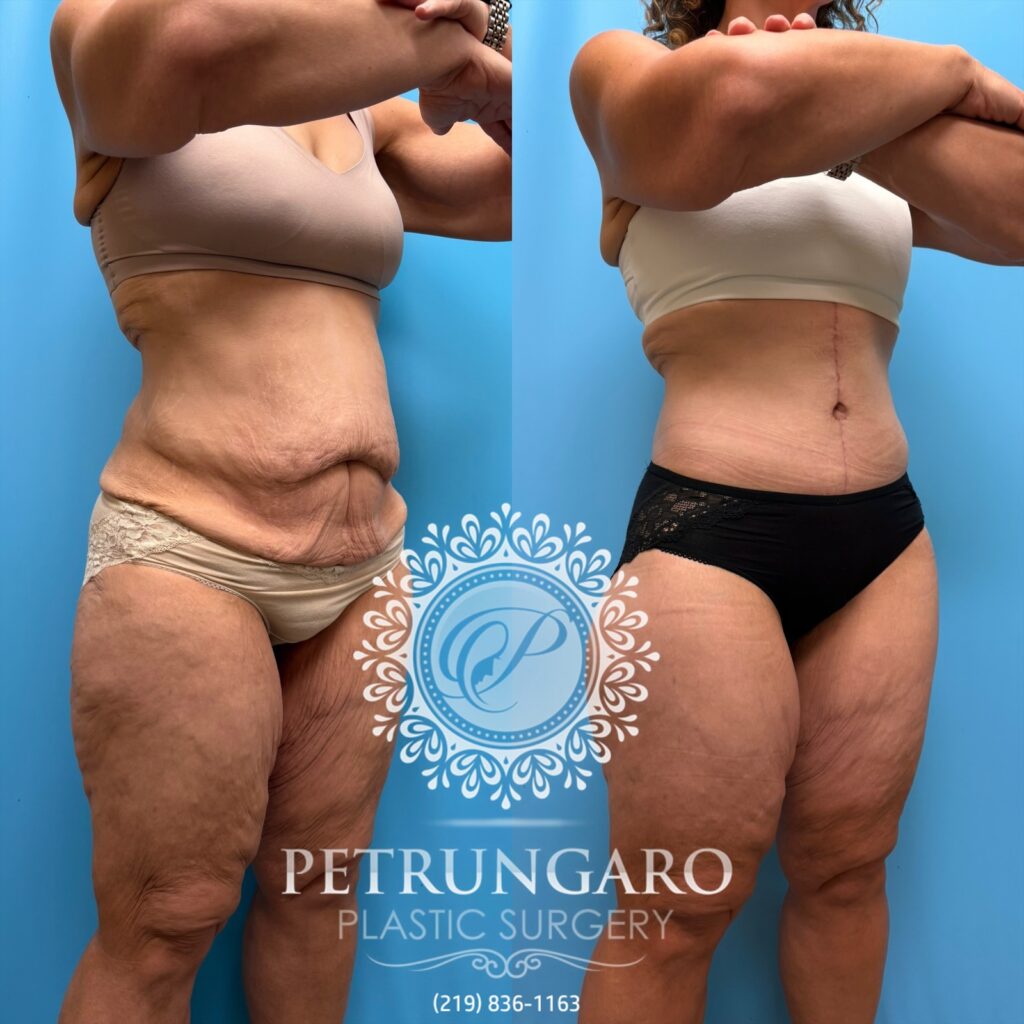
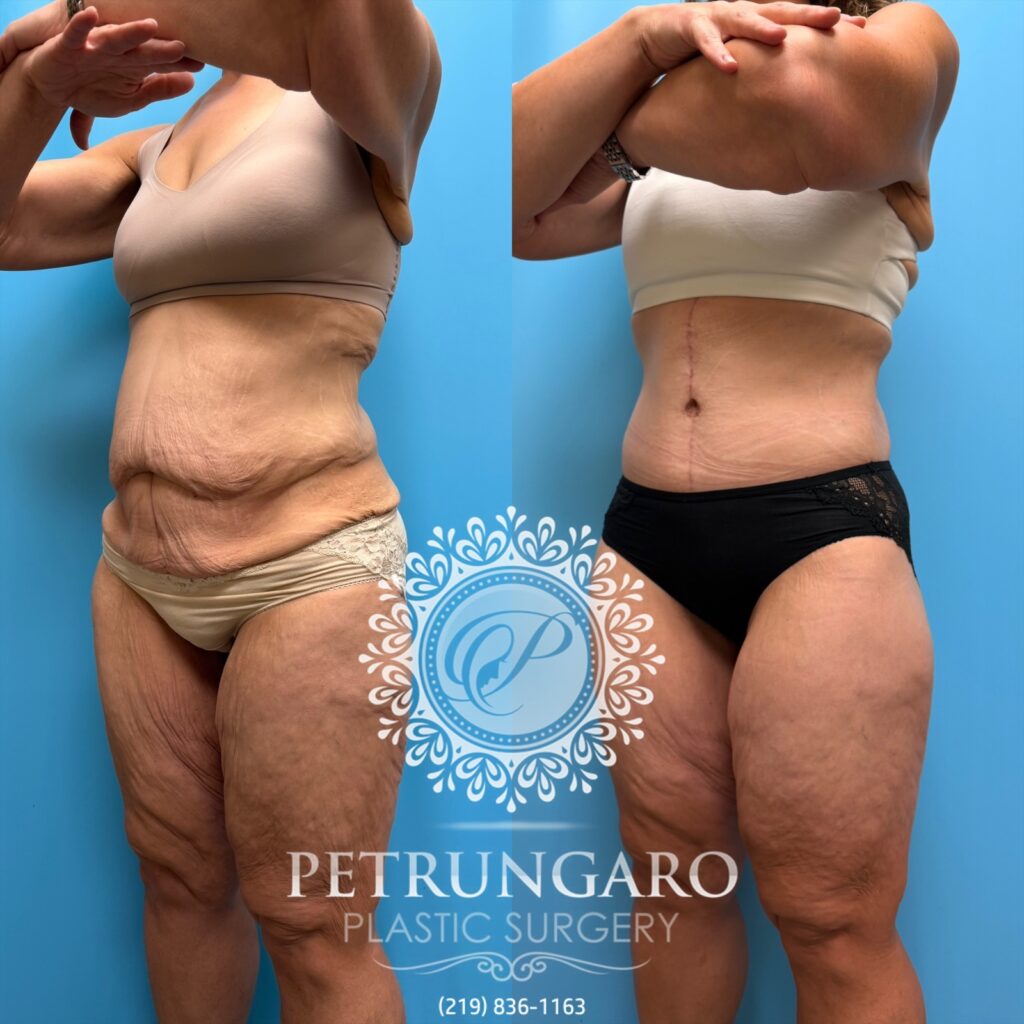
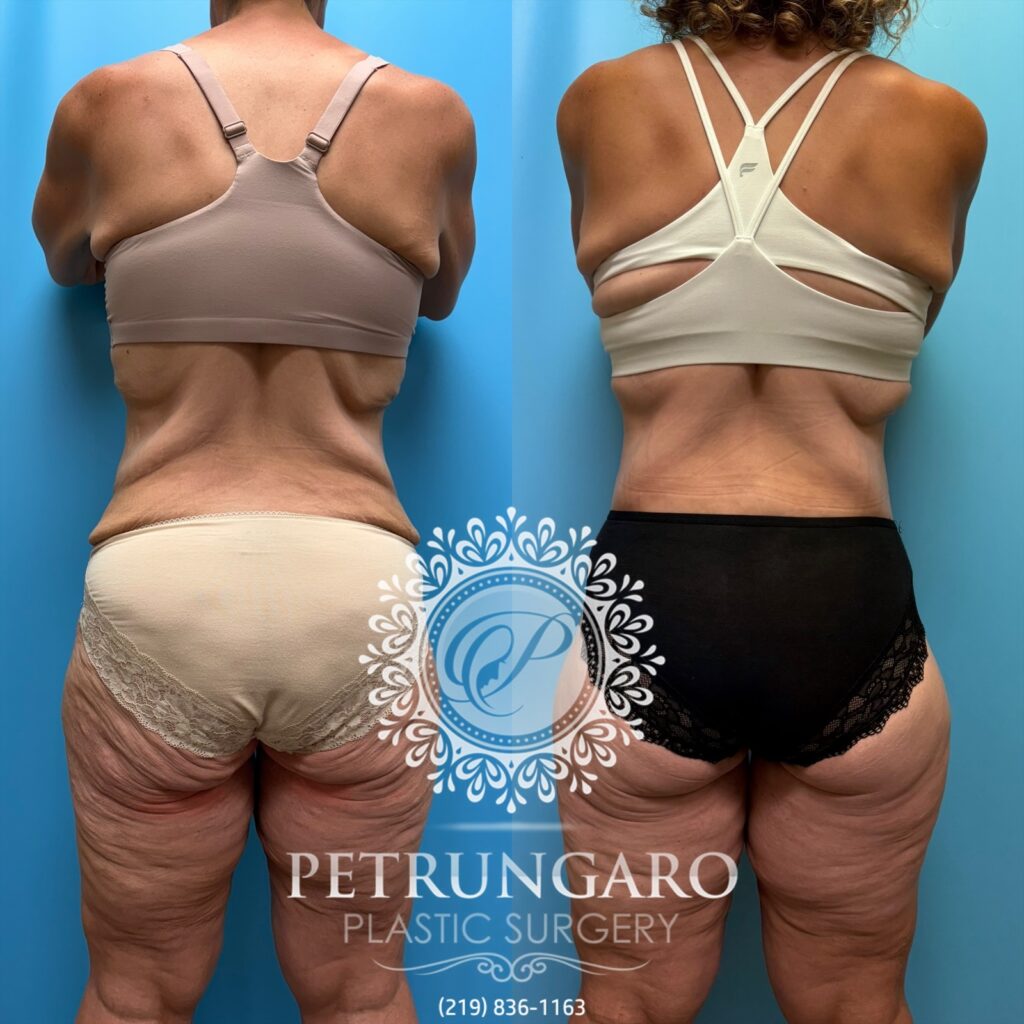
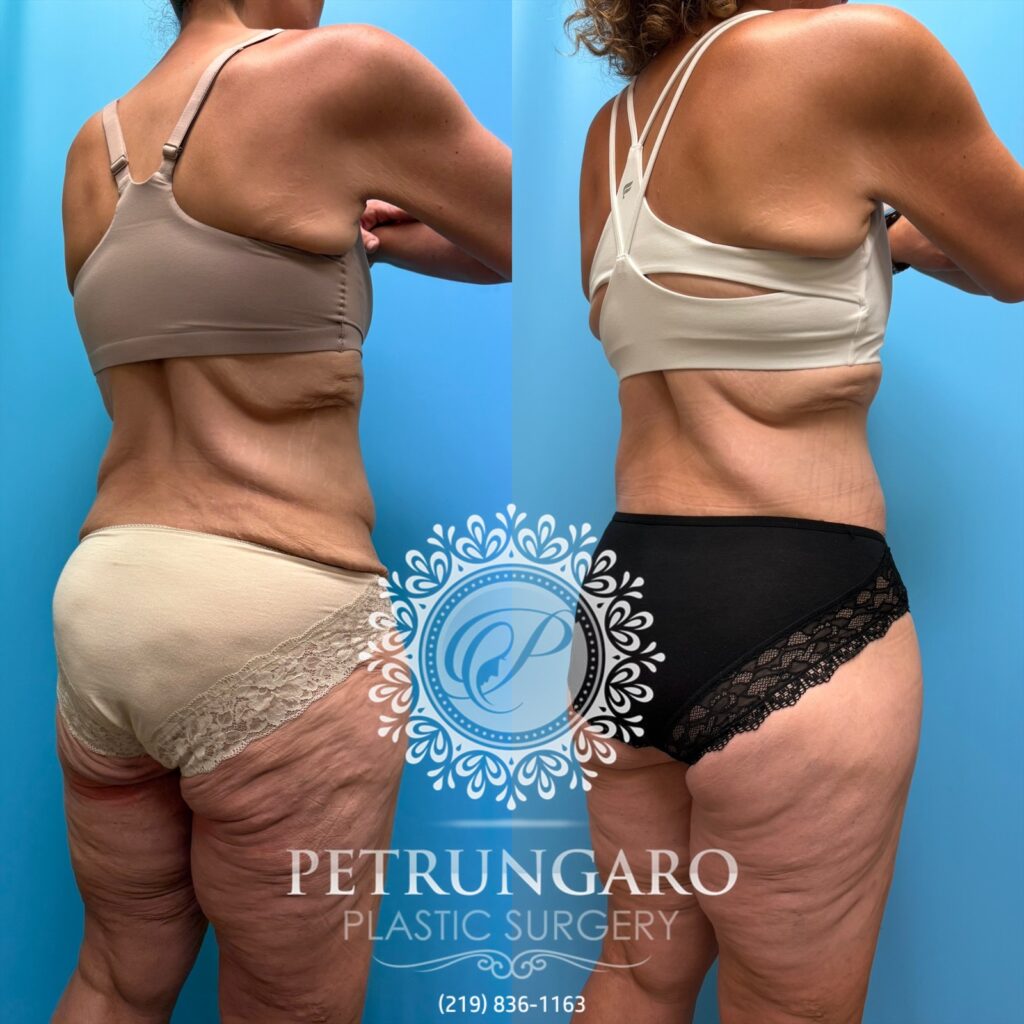
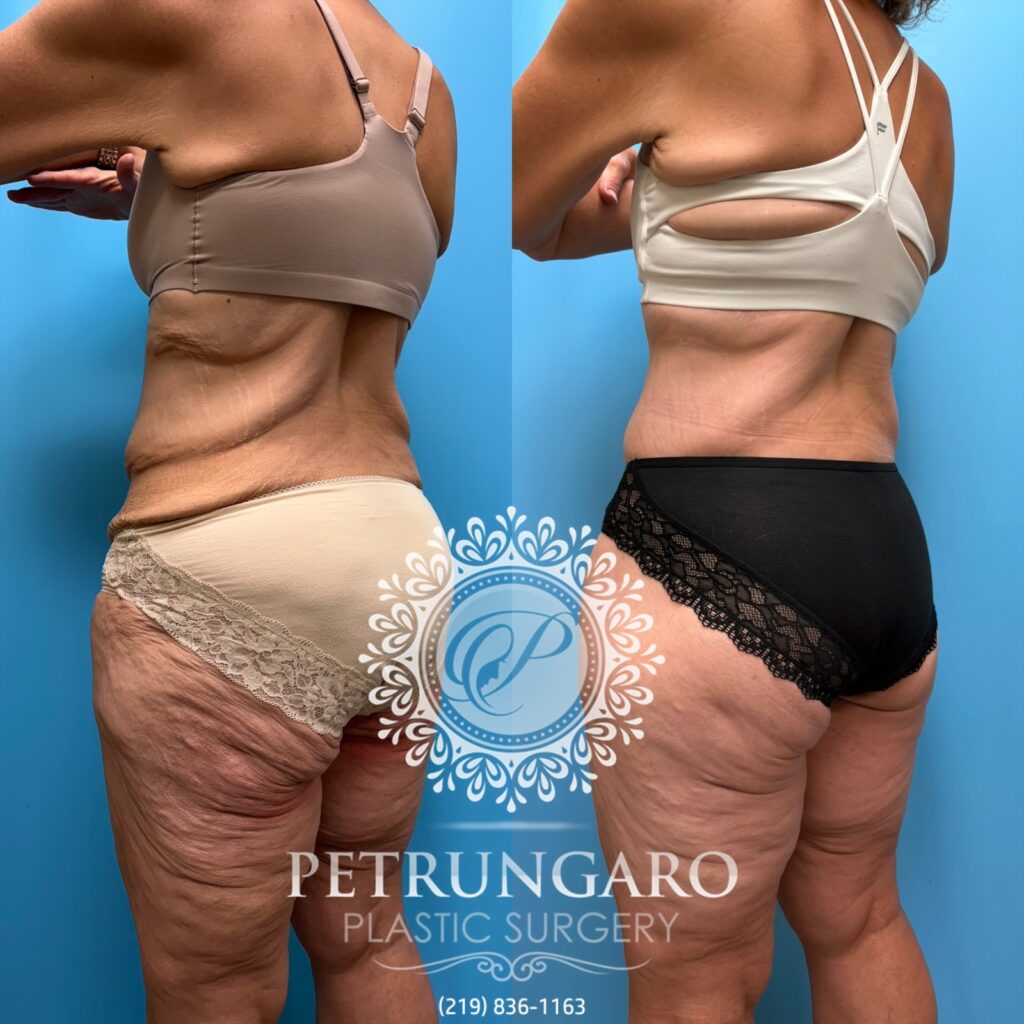
Q&A: Post-Massive Weight Loss Body Contouring with Dr. Jason Petrungaro
Q: What is the biggest difference in recovery between a standard tummy tuck and a full Body Lift?
A: Dr. Jason Petrungaro notes that the primary difference is the initial recovery period and the level of support required. Because the incision is circumferential (360 degrees), the entire torso is involved, leading to a much larger surgical area and a longer period of limited mobility. Patients typically need dedicated help for at least the first seven to ten days, and the overall return to full activity may take slightly longer than a traditional tummy tuck.
Q: Why do I need a Fleur-de-Lis tummy tuck? Can’t you just use the horizontal cut?
A: Dr. Petrungaro explains that the horizontal incision is only effective for vertical skin laxity (up and down) of the LOWER abdomen. If you have severe laxity of the skin of the UPPER abdomen that makes your abdomen very wide or creates horizontal skin folds, the only way to tighten and narrow the abdomen in both the horizontal and vertical directions is by adding the vertical FDL incision. This is often necessary after massive weight loss to achieve a truly flat and narrow contour.
Q: Is the Body Lift a weight-loss procedure?
A: Absolutely not. Dr. Jason Petrungaro stresses that a Body Lift or FDL abdominoplasty is a contouring procedure. While a significant amount of skin and fat tissue is removed (which is measurable weight), you must be at your goal, stable weight for at least six months prior to surgery. The procedure is the final step in your weight loss journey.
Q: Will the Body Lift incision be very noticeable?
A: The Body Lift leaves an incision that wraps entirely around the lower torso. However, Dr. Petrungaro meticulously plans the incision so that it is placed as low as possible on the front (along the bikini line) and rests along the natural fold above the buttock crease in the back. While it is a long scar, Dr. Petrungaro’s goal is to ensure it is concealed by most clothing and swimwear. The vast majority of patients can wear whatever they wish and the circumferential scar will be covered.
Q: Dr. Petrungaro, how soon after bariatric surgery can I have a Body Lift?
A: Dr. Petrungaro requires waiting until you first reach your goal weight AND your weight has then been stable for at least 6 to 12 months. This ensures your body is nutritionally optimized for healing and that you have achieved your final, stable body shape. Nutritional health is paramount for safe surgery and optimal healing.
Q: How do I know if I need a Body Lift versus a standard Tummy Tuck?
A: The best way is through a specialized consultation with a post-weight loss surgery expert like Dr. Jason Petrungaro. Generally, if you have significant sagging skin in your lower back, hips, buttocks, and flanks that pulls down on your abdomen, you likely require the 360-degree lift provided by a Body Lift. Dr. Petrungaro will perform a physical examination to determine the extent of your skin laxity and recommend the appropriate surgical approach.
Q: Can a Body Lift be combined with other procedures?
A: Usually not on the same day due to the length and complexity of the surgery itself. Dr. Jason Petrungaro often performs the Body Lift as the first stage of a total body transformation. It can be combined with liposuction for final detailing, and patients often plan subsequent procedures such as an arm lift (brachioplasty) or a breast lift to address laxity in other areas following their massive weight loss.




